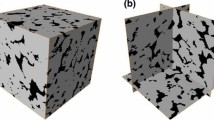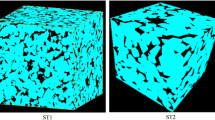Abstract
The heterogeneous pore space of porous media strongly affects the storage and migration of oil and gas in the reservoir. In this paper, the cross-correlation-based simulation (CCSIM) is combined with the three-step sample method to reconstruct stochastically 3D models of the heterogeneous porous media. Moreover, the two-point and multiple-point connectivity probability functions are used as vertical constraint conditions to select the boundary points of pore and matrix, respectively. The heterogeneities of pore spaces of four rock samples are investigated, and then our methods are tested on the four samples. Quantitative comparison is made by computing various statistical and petrophysical properties for the original samples, as well as the reconstructed model. It was found that the results from CCSIM-TSS are obviously better than that from CCSIM. Finally, the analysis of the distance (ANODI) was used to measure of the variability between the realizations of the four rock samples. The results demonstrated that the results from CCSIM-TSSmp are better than that from CCSIM-TSStp as the complexity of connectivity and heterogeneities of pore spaces increase.















Similar content being viewed by others
References
Biswal, B., Manwart, C., Hilfer, R., Bakke, S., Øren, P.E.: Quantitative analysis of experimental and synthetic microstructures for sedimentary rock. Phys. A Stat. Mech. Appl. 273(3), 452–475 (1999)
Biswal, B., Øren, P.E., Held, R.J., Bakke, S., Hilfer, R.: Stochastic multiscale model for carbonate rocks. Phys. Rev. E. 75(6), 061303 (2007)
Bryant, S., Blunt, M.: Prediction of relative permeability in simple porous media. Phys. Rev. A 46(4), 2004–2011 (1992)
Coelho, D., Thovert, J.F., Adler, P.M.: Geometrical and transport properties of random packings of spheres and aspherical particles. Phys. Rev. E 55(2), 1959–1978 (1997)
Gao, M.L., He, X.H., Teng, Q.Z., Zuo, C., Chen, D.D.: Reconstruction of three-dimensional porous media from a single two-dimensional image using three-step sampling. Phys. Rev. E 91, 013308 (2015)
Hajizadeh, A., Farhadpour, Z.: An algorithm for 3D pore space reconstruction from a 2D image using sequential simulation and gradual deformation with the probability perturbation sampler. Transp. Porous Med. 94(3), 859–881 (2012)
Hajizadeh, A., Safekordi, A., Farhadpour, Z.: A multiple-point statistics algorithm for 3D pore space reconstruction from 2D images. Adv. Water Resour. 34(10), 1256–1267 (2011)
Hazlett, R.D.: Statistical characterization and stochastic modeling of pore networks in relation to fluid flow. Math. Geol. 29(6), 801–822 (1997)
Ioannidis, M.A., Chatzis, I., Kwiecien, M.J.: Computer enhanced core analysis for petrophysical properties. J. Can. Pet. Technol. 38, 18–24 (1999)
Krishnan, S., Journel, A.G.: Spatial connectivity: from variograms to multiple-point measures. Math. Geol. 5(8), 915–925 (2003)
Mo, X.W., Zhang, Q., Lu, J.A.: A complement optimization scheme to establish the digital core model based on the simulated annealing method. Chin J. Geophys. 59(5), 1831–1838 (2016)
Øren, P.E., Bakke, S.: Process based reconstruction of sandstones and prediction of transport properties. Transp. Porous Med. 46(2–3), 311–343 (2002)
Øren, P.E., Bakke, S.: Reconstruction of Berea sandstone and pore-scale modeling of wettability effects. J. Pet. Sci. Eng. 39(2), 177–199 (2003)
Payne, S.S., Wild, P., Lubbe, R.: An integrated solution to rock physics modeling in fractured carbonate reservoirs. In: Annual International Meeting, 80th, Society of Exploration Geophysicists. Tulsa, Okla, USA: Society of Exploration Geophysicists, vol. 1, pp. 358–362 (2010)
Quiblier, J.A.: A new three-dimensional modeling technique for studying porous media. J. Colloid Interface Sci. 98(1), 84–102 (1984)
Strebelle, S.: Conditional simulation of complex geological structures using multiple-point geostatistics. Math. Geol. 34, 1–22 (2002)
Strebelle, S., Cavelius, C.: Solving speed and memory issues in multiple-point statistics simulation program SNESIM. Math. Geol. 46(2), 171–186 (2014)
Tahmasebi, P., Sahimi, M.: Enhancing multiple-point geostatistical modeling: 1. Graph theory and pattern adjustment. Water Resour. Res. 52(3), 2074–2098 (2016)
Tahmasebi, P., Hezarkhani, A., Sahimi, M.: Multiple-point geostatistical modeling based on the crosscorrelation functions. Comput. Geosci. 16(3), 779–797 (2012)
Tahmasebi, P., Javadpour, F., Sahimi, M.: Three-dimensional stochastic characterization of shale SEM images. Transp. Porous Med. 110, 521–531 (2015)
Tahmasebi, P., Javadpour, F., Sahimi, M., Piri, M.: Multiscale study for stochastic characterization of shale samples. Adv. Water Resour. 89, 91–103 (2016)
Tan, X.J., Tahmasebi, P., Caers, J.: Comparing training-image based algorithms using an analysis of distance. Math. Geosci. 46, 149–169 (2014)
Thovert, J.F., Adler, P.M.: Grain reconstruction of porous media: application to a Bentheim sandstone. Phys. Rev. E 83(5), 6116–6129 (2011)
Thovert, J.F., Yousefian, F., Spanne, P.: Grain reconstruction of porous media: application to a low-porosity Fontainebleau sandstone. Phys. Rev. E 63(6), 1307–1323 (2001)
Weger, R.J., Eberli, G.P., Baechle, G.T., Massaferro, J.L., Sun, Y.F.: Quantification of pore structure and its effect on sonic velocity and permeability in carbonates. AAPG Bull. 93(10), 1297–1317 (2009)
Yao, J., Wang, C.C., Yang, Y.F., Hu, R.R., Wang, X.: The construction of carbonate digital rock with hybrid superposition method. J. Pet. Sci. Eng. 110, 263–267 (2013)
Yi, Z.X., Lin, M., Jiang, W.B., Zhang, Z.B., Li, H.S., Gao, J.: Pore network extraction from pore space images of various porous media systems. Water Resour. Res. (2017). 53(4), 3424–3445 (2017)
Acknowledgements
This work is supported by the Strategic Priority Research Program of the Chinese Academy of Sciences (grant No. XDA14010304), the National Natural Science Foundation of China (Grant No. 41404114 and No. 41690132), the National Program on Key Basic Research Project (973 Program, Grant No. 2014CB239004) and the Strategic Priority Research Program of the Chinese Academy of Sciences (Grant No. XDB10020302).
Author information
Authors and Affiliations
Corresponding author
Appendices
Appendices
1.1 A. Two-Point Correlation Function (ACF)
The void–void (pore–pore) ACF is defined by
where the averaging is over all locations u within the volume, and I(u) is an indicator function such that \(I(u) = 1\), if u is in the pore space, and \(I(u) = 0\) otherwise. The porosity is simply \(\varphi =E\left\{ {I(u)} \right\} \), \(E\left\{ {I(u)} \right\} \) is the mean of I(u) over all locations u within the volume.
1.2 B. Multiple-Point Connectivity Probability Functions
The multiple-points connectivity probability is proposed by Krishnan and Journel (2003). It is a measure of the connectivity of the system within an image. The truncated tolerance cone is defined, as shown in Fig. 16. Consider a seed location u in channel: \(I (u) = 1\) (u is in the pore space). Within the defined tolerance cone, we would like to connect u through a channel path to another maximally distant location u is in the pore space \(u'\), that distance being measured along the axis of the cone.
More precisely, the calculation of the multiple-points connectivity probability proceeds as:
Loop through all nodes u of the study area.
-
If I \((u) = 0\), set \(d\hbox {max} = 0\) and go to next node u.
-
If I \((u) = 1\), i.e., location u belongs to the pore space, call MATLAB function bwselect to determine within the tolerance cone with apex at u, the set (body) of all locations \(u'\) belonging to the pore space, i.e., I \((u') = 1\). Loop through all these locations \(u'\) and determine the maximum distance dmax to the apex u. Increment the n proportions of continuous (and curvilinear) channel paths of length \(n\vec {h}\le d\hbox {max}\). \(\vec {h}\) is a unit vector in any given direction.
It should be emphasized that the tolerance angle is \(\pm \, 22.5^{\circ }\), the bandwidth is 10 pixels during calculating the curvilinear directional connectivity in this paper.
Rights and permissions
About this article
Cite this article
Ji, L., Lin, M., Jiang, W. et al. An Improved Method for Reconstructing the Digital Core Model of Heterogeneous Porous Media. Transp Porous Med 121, 389–406 (2018). https://doi.org/10.1007/s11242-017-0970-5
Received:
Accepted:
Published:
Issue Date:
DOI: https://doi.org/10.1007/s11242-017-0970-5





